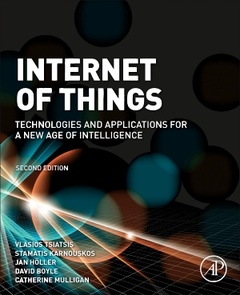Description
Internet of Things (2nd Ed.)
Technologies and Applications for a New Age of Intelligence
Authors: Tsiatsis Vlasios, Karnouskos Stamatis, Holler Jan, Boyle David, Mulligan Catherine
Language: English
Subject for Internet of Things:
Keywords
alliances; architecture; Architecture Reference Model (ARM); Architecture Views; Physical Entity; Virtual Entity; Assistive technologies; concerns; connected devices; consumer; demand flow; Demand–Response; design principles; distribution; Energy Management; Energy Services; EPCIS; food transport; forecast; functions; GS1; Human computer interactions; IIC Reference Architecture; Industrial Internet Consortium (IIC); Information Technology (IT); Inventory Management; IoT Domain Model; IoT-A; Logistics; manufacturer; market potential; market size; monitoring; open source; Operational Technology (OT); product flow; requirements; retail; RFID; Smart City; Smart Grid; Smart Metering; Smart sensor; stakeholders; standards; supplier; Supply Chain Management; system; Third Party Logistics Provider; transformation; transportation; User centred design; User involvement; User profile; warehousing
97.13 €
In Print (Delivery period: 14 days).
Add to cart390 p. · 19x23.3 cm · Paperback
Description
/li>Contents
/li>Biography
/li>Comment
/li>
Internet of Things: Technologies and Applications for a New Age of Intelligence outlines the background and overall vision for the Internet of Things (IoT) and Cyber-Physical Systems (CPS), as well as associated emerging technologies. Key technologies are described including device communication and interactions, connectivity of devices to cloud-based infrastructures, distributed and edge computing, data collection, and methods to derive information and knowledge from connected devices and systems using artificial intelligence and machine learning. Also included are system architectures and ways to integrate these with enterprise architectures, and considerations on potential business impacts and regulatory requirements.
New to this edition: ? Updated material on current market situation and outlook.? A description of the latest developments of standards, alliances, and consortia. More specifically the creation of the Industrial Internet Consortium (IIC) and its architecture and reference documents, the creation of the Reference Architectural Model for Industrie 4.0 (RAMI 4.0), the exponential growth of the number of working groups in the Internet Engineering Task Force (IETF), the transformation of the Open Mobile Alliance (OMA) to OMA SpecWorks and the introduction of OMA LightweightM2M device management and service enablement protocol, the initial steps in the specification of the architecture of Web of Things (WoT) by World Wide Consortium (W3C), the GS1 architecture and standards, the transformation of ETSI-M2M to oneM2M, and a few key facts about the Open Connectivity Forum (OCF), IEEE, IEC/ISO, AIOTI, and NIST CPS.? The emergence of new technologies such as distributed ledgers, distributed cloud and edge computing, and the use of machine learning and artificial intelligence for IoT.? A chapter on security, outlining the basic principles for secure IoT installations.? New use case description material on Logistics, Autonomous Vehicles, and Systems of CPS
PART 1 THE EVOLVING IoT LANDSCAPE1. Introduction2. Origins and IoT Landscape3. A Market Perspective4. An Architectural Perspective
PART 2 IoT TECHNOLOGIES AND ARCHITECTURES5. Technology Fundamentals6. Security7. Trust, Identity and Privacy8. Standards Architecture9. IoT Architecture and State of the Art Reference Model10. Real-World Design Constraints
PART 3 USE CASES11. Introduction to Use12. Asset Management13. Industrial Automation14. The Smart Grid15. Commercial Building Automation16. Smart Cities17. Participatory Sensing18. Robotics19. Autonomous Vehicles20. Logistics21. Conclusions and Looking Ahead
Appendix A - Open source software implementations to use IoT
and analytics. He holds a PhD in the area of Networked Embedded Systems from the University of California, Los Angeles.
Stamatis Karnouskos is an expert on the IoT at SAP, Germany. He investigates the added value and impact of emerging technologies in enterprise systems. For over 20 years, he has led efforts in several European Commission and industry-funded projects relate to IoT, Cyber-Physical Systems, Industrie 4.0, manufacturing, smart grids, smart cities, security, and mobility. Stamatis has extensive experience in research and technology management within the industry as well as the European Commission and several national research funding bodies (e.g., in Germany, France, Switzerland, Denmark, Czech Republic, and Greece). He has served on the technical advisory board of the Internet Protocol for Smart Objects (IPSO) Alliance and the Permanent Stakeholder Group of the European Network and nformation Security Agency (ENISA).
Jan Höller is a Research Fellow at Ericsson Research, where he has a responsibility to define and drive technology and research strategies and to contribute to the corporate strategies for the IoT. He established Ericsson’s research activities i
- Standards organizations covered: IEEE, 3GPP, IETF, IEC/ISO, Industrial Internet Consortium (IIC), ITU-T, GS1, Open Geospatial Consortium (OGC), Open Mobile Alliance (OMA, e.g. LightweightM2M), Object Management Group (OMG, e.g. Business Process Modelling Notation (BPMN)), oneM2M, Open Connectivity Forum (OCF), W3C
- Key technologies for IoT covered: Embedded systems hardware and software, devices and gateways, capillary networks, local and wide area networking, IoT data management and data warehousing, data analytics and big data, complex event processing and stream analytics, control systems, machine learning and artificial intelligence, distributed cloud and edge computing, and business process and enterprise integration
- In-depth security solutions for IoT systems
- Technical explanations combined with design features of IoT and use cases, which help the development of real-world solutions
- Detailed descriptions of the architectures and technologies that form the basis of IoT
- Clear examples of IoT use cases from real-world implementations such as Smart Grid, Smart Buildings, Smart Cities, Logistics and Participatory Sensing, Industrial Automation, and Systems of CPS
- Market perspectives, IoT evolution, and future outlook

